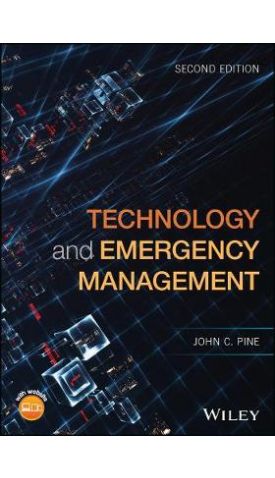אנו משתמשים ב-Cookies כדי לשפר את החוויה שלך. כדי לקיים ההנחיה החדשה של e-Privacy, עלינו לבקש את הסכמתך להגדיר את ה-Cookies. קבלת מידע נוסף.
467.00 ₪
Technology and Emergency Management 2e
467.00 ₪
ISBN13
9781119234081
יצא לאור ב
Hoboken
מהדורה
2nd Edition
זמן אספקה
21 ימי עסקים
עמודים
288
פורמט
Paperback / softback
תאריך יציאה לאור
6 באוק׳ 2017
מחליף את פריט
14678973000
The first book devoted to a critically important aspect of disaster planning, management, and mitigation Technology and Emergency Management, Second Edition describes best practices for technology use in emergency planning, response, recovery, and mitigation.
The first book devoted to a critically important aspect of disaster planning, management, and mitigation Technology and Emergency Management, Second Edition describes best practices for technology use in emergency planning, response, recovery, and mitigation. It also describes the key elements that must be in place for technology to enhance the emergency management process. The tools, resources, and strategies discussed have been applied by organizations worldwide tasked with planning for and managing every variety of natural and man-made hazard and disaster. Illustrative case studies based on their experiences appear throughout the book. This new addition of the critically acclaimed guide has been fully updated and expanded to reflect significant developments occurring in the field over the past decade. It features in-depth coverage of major advances in GIS technologies, including the development of mapping tools and high-resolution remote sensing imaging.
Also covered is the increase in computer processing power and mobility and enhanced analytical capabilities for assessing the present conditions of natural systems and extrapolating from them to create accurate models of potential crisis conditions. This second edition also features a new section on cybersecurity and a new chapter on social media and disaster preparedness, response, and recovery has been added.
* Explores the role of technology in emergency planning, response, recovery, and mitigation efforts * Explores applications of the Internet, telecommunications, and networks to emergency management, as well as geospatial technologies and their applications * Reviews the elements of hazard models and the relative strengths and weaknesses of modeling programs * Describes techniques for developing hazard prediction models using direct and remote sensing data * Includes test questions for each chapter, and a solutions manual and PowerPoint slides are available on a companion website Technology and Emergency Management, Second Edition is a valuable working resource for practicing emergency managers and an excellent supplementary text for undergraduate and graduate students in emergency management and disaster management programs, urban and regional planning, and related fields.
| מהדורה | 2nd Edition |
|---|---|
| עמודים | 288 |
| מחליף את פריט | 14678973000 |
| פורמט | Paperback / softback |
| ISBN10 | 1119234085 |
| יצא לאור ב | Hoboken |
| תאריך יציאה לאור | 6 באוק׳ 2017 |
| תוכן עניינים | Chapter 1 :The Need for Technology in Emergency Management 1.1 Technology and Disaster Management 1.2 Technology as a Management Tool 1.3 Using Technologies 1.4 Completing a Needs Assessment Chapter 2: Computer Networks and Emergency Management 2.1 What is a Network? 2.2 Types of Networks 2.3 The Internet 2.4 Communication Technologies 2.5 The Internet and Emergency Management 2. 6 The Internet of Things (IoT) and Emergency Management Chapter 3: Cybersecurity 3.1 Sources of Attacks 3.2 Attack Vectors 3.3 Overview of Malware 3.4 Securing Cyber Systems 3.5 Securing Data Chapter 4: Social Media and Emergency Management 4.1 Situational awareness, emergency communications and the public realm 4.2 What is Social Media? 4.3 Types of Social Media Used in Disasters 4.4 Mass alert systems 4.5 Mass media and social media use in Virginia Tech shooting response 4.6 What is a disaster? 4.7 Usage patterns of social media over time 4.8 Social media s growth and the role of traditional sources 4.9 Use of social media for preparedness and planning 4.10 Use of social media before and during mass emergencies 4.11 Issues arising from the use of social media by emergency managers during events 4.12 Using social media to establish information on damages and recovery 4.13 The advantages and fallbacks of geotargeting 4.14 Social media companies contribution to emergency response 4.15 Concerns about and limitations of social media usage in disasters 4.16 The future of social media in disasters 4.17 Looking forward Chapter 5: Geospatial Technologies and Emergency Management 5.1 Geotechnical Technologies and Emergency Management 5.2 Geospatial Technologies across the Human-Hazard Interface 5.3 Our Resources 5.4 Understanding Our Hazards 5.5. Dissemination and Hazard Communication 5.6 Summary 5.7 Conclusions Chapter 6: Direct and Remote Sensing Systems: Describing and detecting hazards 6.1 DATA COLLECTION 6.2 Weather Station Data 6.3 WATER DATA SENSORS 6.4 EVALUATING THE TECHNOLOGY 6.5 REMOTE SENSING 6.8 USING AND ASSESSING DATA 6.9 TRENDS IN REMOTE AND DIRECT SENSING TECHNOLOGY Chapter 7: EMERGENCY MANAGEMENT DECISION SUPPORT SYSTEMS: Using Data to Manage Disasters 7.1 Emergency Management Information Systems and Networks 7.2 Evaluating Information Systems 7.3 Federal, State, and Local Information Systems 7.4 Using Data 7.5 Evaluating Databases 7.7 Using Emergency Management Databases 7.8 Management Roles in Decision Support Systems 7.9 Obtaining Data from Public Federal Data Sources Chapter 8: Warning Systems: Alerting the Public to Danger 8.1 Warning Systems 8.2 Detection and Management 8.3 Issuing Warnings 8.4 Types of Warning Systems 8.5 Response Chapter 9: HAZARDS ANALYSIS AND MODELING Predicting the Impact of Disasters 9.1 Modeling and Emergency Management 9.2 Using a Hurricane Model (SLOSH) 9.3 Using the ALOHA Chemical Dispersion Model 9.4 Hazards United States-Multi Hazard Model (HAZUS-MH) 9.5 Evacuation Modeling 9.6 Centralized Hazard Modeling Initiatives 9.7 Evaluating Hazard Models Chapter 10: Operational Problems and Technology: Making Technology Work for You 10.1 Barriers in Implementing Technology in Emergency Management 10.2 The Role of the Emergency Manager in Using Technology 10.3 Using Technology to Overcome Organizational Boundaries 10.4 Pitfalls of Technology 10.5 Managing the Technology Chapter 11: TRENDS IN TECHNOLOGY: New Tools for Challenges to Emergency Management 11.1 Using Technology for Information Exchange 11.2 Distance Learning 11.4 Managing the Technology |
| זמן אספקה | 21 ימי עסקים |



Login and Registration Form